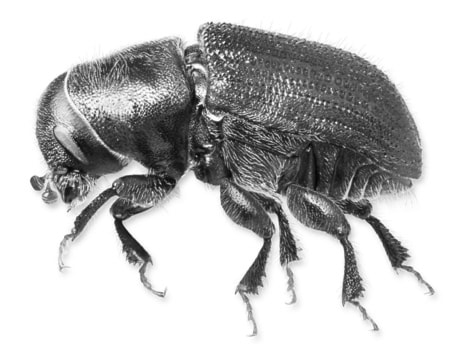EDMONTON — Alberta researchers say the destructive mountain pine beetle has infested a different type of tree that could allow the pest to spread eastward across Canada.
University of Alberta scientists say they have proven the tiny beetles can jump species from the lodgepole pines of Western Canada to Jack pines, the main trees in the boreal forest.
The beetles have been found in Jack pines north of Edmonton and the bugs are knocking on Saskatchewan’s door.
“Here we show for the first time successful mountain pine beetle attack in natural Jack pine stands at the leading edge of the epidemic,” reads a study published Monday in the journal Molecular Ecology.
“This once unsuitable habitat is now a novel environment for mountain pine beetle to exploit, a potential risk which could be exacerbated by further climate change. The consequences of host-range expansion for the vast ecosystem could be significant.”
Beetle experts in British Columbia and Alberta have been fearing and predicting such a trend for years. The bugs kill the pine by depositing a fungus in the tree’s bark.
The concern is the beetle, which has already killed millions of mature lodgepole pines in the West, could gradually cause similar havoc in the boreal forest that runs eastward all the way to Atlantic Canada.
Professor Janice Cooke said the beetles spread through hybrid trees that have acted like a bridge between the two types of timber. The hybrids don’t look any different to the naked eye. The findings are based on molecular tests done on samples from the needles of infested trees.
“We grind those needles up to do an extraction of DNA just like they would for human genetics,” said Cooke, who conducted the study along with fellow biology Prof. Catherine Cullingham.
“This shows for the first time that mountain pine beetle is in the boreal forest and the boreal forest extends to Eastern Canada. The mountain pine beetle has breached that barrier. How far eastward it moves is now in the hands of Mother Nature.”
Moderate winter and summer temperatures allow the beetles to survive and fully develop. The black bugs spread when newly born larvae develop wings in summer and fly in search of more trees or are blown eastward by prevailing westerly winds.
To get a sense of the possible implications one only has to look at how the beetles have ravaged timber stands in B.C. and Alberta.
Alberta has spent about $255 million fighting the beetle since 2006 and estimates the bugs have infested about 3.2 million trees in the province.
In British Columbia, the beetles have attacked pine forests over an area five times the size of Vancouver Island and have killed 675 million cubic metres of timber. The devastation has damaged the economies of small communities in the B.C. interior. The huge areas of dry, dead timber have also acted like a tinder box, fuelling massive forest fires that have forced thousands of people from their homes.
Alberta government spokesman Duncan MacDonnell said the study shows the beetle battle is a problem of national concern.
“It confirms that the beetle is a threat to the national forest of Canada, not just the lodgepole pine in Alberta. Jack pine stretches all the way to Labrador,” he said.
“It underlines the importance of Alberta’s fight against the beetle. We are the front line now.”
Alberta has just concluded a winter campaign in which crews removed and destroyed 170,000 infested trees. Experts believe beetles from each of those trees could have spread to 10 more trees this summer. Crews are now waiting to assess how many of the bugs survived the cold.
Cooke said the study doesn’t forecast when or how quickly the beetles could spread east.
“How long that might take, that would take a crystal ball. But all the conditions have been met for that to happen if the climate conditions are favourable for the beetle.”
